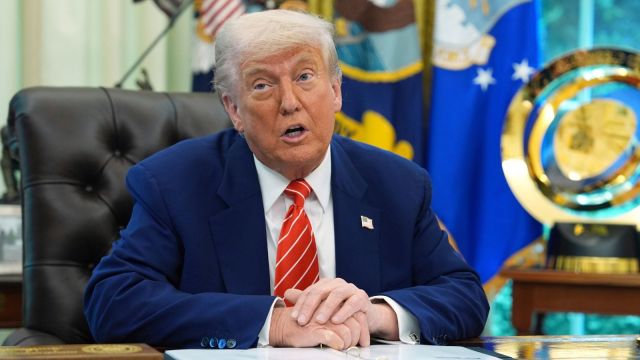Stay updated with the latest - Click here to follow us on Instagram
Trump signs order to double steel and aluminium tariffs to 50%, exempts UK
Trump Tariffs on Foreign Steel and Aluminum Imports: According to the US government, America is the biggest importer of steel in the world, after the European Union.
 During Trump’s first tenure, the US had imposed a 25% tariff on steel and 10% tariff on aluminium. (AP)
During Trump’s first tenure, the US had imposed a 25% tariff on steel and 10% tariff on aluminium. (AP)Trump Executive Order on Foreign Steel and Aluminum Imports: President Donald Trump has signed an executive order to double tariffs on nearly all steel and aluminium imports to 50 per cent, marking a significant escalation in his administration’s ongoing effort to reshape global trade dynamics.
The announcement, made in a formal proclamation issued on Tuesday, signals the second such increase since March and will take effect from Wednesday. It raises the levies from the longstanding 25 per cent rate that had been in place since 2018, when Trump first introduced sweeping tariffs on metals under Section 232 of the Trade Expansion Act, citing national security concerns.
The move excludes the United Kingdom, which signed a bilateral agreement last month. Under the terms of the deal, the UK will see no further increase in tariffs; the current 25 per cent rate will be maintained, with provisions for a possible adjustment beginning July 9 depending on British compliance with the agreed trade framework.
What did Trump say?
President Trump justified the tariff hike as a necessary intervention to protect critical US industries. During a recent visit to US Steel’s Mon Valley Works–Irvin Plant near Pittsburgh, Trump described the move as a “decisive step” to “secure the future of the American steel industry.” He further cited a proposed partnership between US Steel and Japan’s Nippon Steel as evidence of renewed confidence in the domestic market.
President Trump just signed a proclamation raising tariffs on steel and aluminum imports by 50% to protect U.S. steel and national security.🇺🇸
THE GOLDEN AGE IS HERE! pic.twitter.com/TP32u0M4dR
— The White House (@WhiteHouse) June 3, 2025
“Imported steel and aluminium continue to pose a threat to our national security,” Trump said. “These increased tariffs will more effectively counter foreign countries that offload low-priced, excess production into the United States.”
What can be the impact?
Steel and aluminium are core components of a vast spectrum of products, from canned goods and household electronics to construction materials and automobiles. As such, economists and industry leaders warn that doubling tariffs will have wide-ranging effects across supply chains and could lead to significant price pressures for both producers and consumers.
Manufacturers that depend on imported metals — particularly in the automotive, electronics, and food packaging sectors — are expected to face elevated input costs, which may be passed on to consumers. Even companies that use domestically produced metals could see price increases as US suppliers take advantage of reduced foreign competition.
Since Trump took office in January, steel prices in the United States have risen by 16 per cent, reaching $984 per metric tonne as of March — well above prices in Europe ($690) and China ($392), according to data from the US Commerce Department.
David McCall, international president of the United Steelworkers union, welcomed the renewed focus on domestic production but urged the administration to look beyond tariffs alone.
“Tariffs, used strategically, serve as a valuable tool in balancing the scales,” McCall said in a statement. “But we must also pursue broader reforms of our global trading system in collaboration with trusted allies such as Canada.”
Matt Meenan, vice president of external affairs at the Aluminum Association, too, said: “We appreciate President Trump’s continued focus on strengthening the US aluminium industry.” “But tariffs alone will not increase primary aluminium production. We also need consistent, predictable trade and tariff policy to plan for current and future investment.”
Why was UK left out?
The United Kingdom remains the notable exception to the tariff hike. A trade agreement finalised on May 8 guarantees British exporters of steel and aluminium continued access to the US market at the existing 25 per cent tariff level.
The agreement is, however, conditional. US authorities may revise the UK’s tariff status after July 9 if the country fails to meet the terms of the trade framework.



- 01
- 02
- 03
- 04
- 05



























